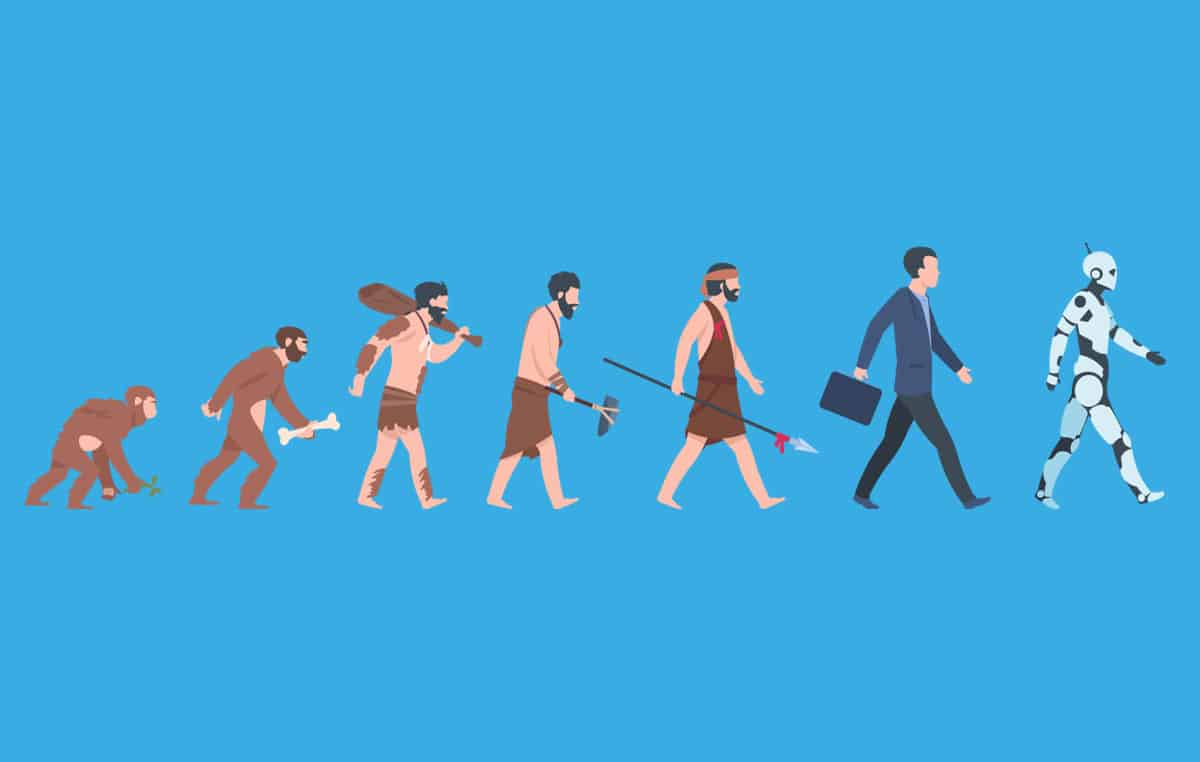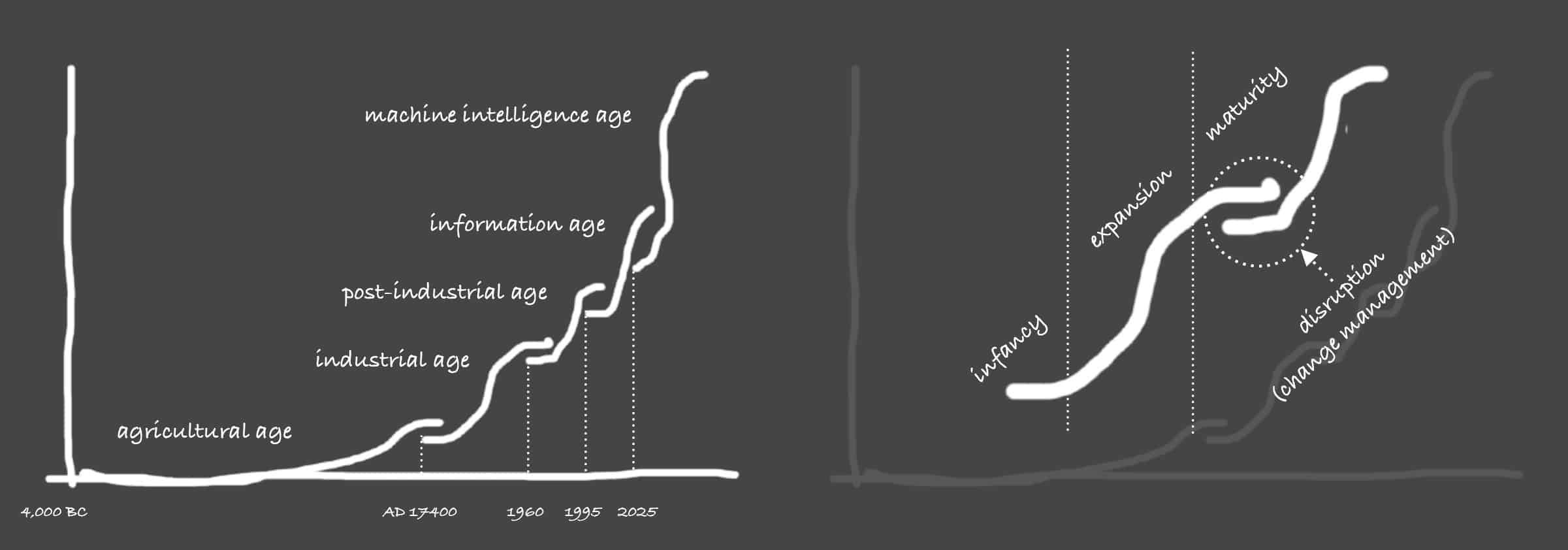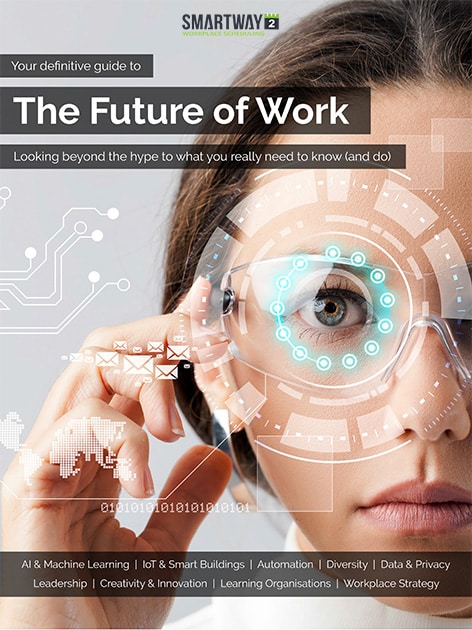
Technological Forecasting & Social Change
Take a few seconds to work out how many years there are likely to be between now and your retirement. Since our brains are wired to think linearly, we naturally assume that the amount of change that’ll happen in these years will be roughly the same as that which we’ve experienced so far. Regardless of how often we hear the mantra that ‘the pace of change is accelerating’, are we underestimating just how much newness we need to prepare for?
Ray Kurzweil’s law of accelerating returns describes how society keeps growing more advanced, causing change to accelerate… precisely because we’re more advanced. In other words, we create new tools and innovations that enable us to create new tools and innovations that enable us to create new tools and innovations… And with each cycle of newness, we move higher up the chain of innovation. Put another way, no single person knows how to make a toaster.
The person who assembled it in the factory didn’t know how to drill the oil well to make the plastic. Chances are neither you nor I know how to mine iron, build a furnace or any of the other processes involved in making a toaster from scratch.
If we were to attempt making a toaster from scratch, it might end up looking something like this…

Thomas Thwaites made this toaster from scratch in 2009, to demonstrate just how far we’ve come from self- sufficiency towards interdependence.
This very morning, you probably consumed goods and services from dozens of countries, created by a seething global network of people and organizations, all collaborating and inventing – creating the building blocks and tools that enable more people to make more stuff that saves more time so we can make more stuff and live better lives.
The more complex and interconnected this network grows – the more it learns and interacts and connects – the more our creativity is unleashed (e.g. you no longer need to be able to code to make a website, let alone grind wheat into flour to make bread). We keep on rising up and specializing, so as individuals we can focus on where we can add the most cognitive value.
Gamechangers
This uprising happens in fits and starts, as paradigm shifts burst onto the scene and change the game. AI is one such game changing technology. The trouble is, the pattern of change causes us to overestimate how much things will change in the short term, when we’re at the foot of the curve; and underestimate how much things will change in the long term.
To illustrate the severity of this underestimation… Imagine you’re Marty in Back to the Future. Your kid self goes back in time to when your parents were kids. You’d be a little shocked by what you saw, but not too shocked. Now imagine if your kid went back in time to when you were a kid – before mobile phones and the internet – the shock would be somewhat more severe.
If in future your grandkid could go back to when your kid was a kid, the shock would be mindblowing.
And so it goes on, as the cycles of change compress and quicken with each year that goes by. That’s why all progress throughout the entire 20th century would have been achieved in just 20 years at the rate of advancement in year 2000. Another 20th century’s worth of progress happened between 2000 and 2014.
And another will happen between 2014 and 2021.
In another 20 years, according to Ray, a 20th century worth of progress will happen several times a year; then later in less than a month.
Likewise if you zoom back 30 or 50 thousand years, something drastic was happening to we homosapiens. Our brains had increased in size and our way of thinking changed. Culture started to develop rapidly and we began to revolutionize our toolkit: slim, sharp blades, spears, needles. We got a bit arty too, making ornaments out of shell, ivory and stone.
The pace of change and innovation was lightning fast. It kept on coming: fish hooks, domesticated wolves, wheat crops, money. There was more innovation between twenty and eighty thousand years ago than there had been in the previous million years. And so the futurist’s mantras go: ‘never before have culture, communications and technology moved faster than they are today’ – statements the like of which will always be true when they are spoken.
If Ray Kurzweil, lots of scientists and logical reasoning based on historical patterns are all correct, we could all be in for a major shock by 2030. The same level of shock someone from the 16th century might experience if we transported them into this room right now.
The shape of change
Change happens in a series of S curves that start slowly, rapidly speed up, then level off. The same pattern holds true whether it’s applied to paradigm shifts in economics, new technologies, or company transformation. You start off in the realms of status quo, quite sure of the old way. Then there’s an inflection point where the old and new collide, catalyzing change. A period of disruption follows, where you should closely manage the change – then you settle into the new way (which becomes the new status quo, ready to be disrupted).

Just remember that you’re probably judging the next 20 years of progress based on the previous 20 years you’ve just lived through. This is a natural mistake. It’s natural for us to think linearly, while change is exponential. It’s natural for us to imagine the future based on past experience – your personal notion of ‘how things work’ – despite past experience being a very poor way to judge the future. It isn’t just linear thinking that’s leading us into a false sense of slow – it’s the basic math.
We underestimate how drastically work will change over the course of our careers because exponential progress is a sneaky beast. At first, when advances in a particular area like Artificial Intelligence start doubling, the change remains very small for a long time. For example if you double every year from 0.00001 to 0.00002, it’s no big deal. If you double 0.00002, you get 0.00004… and so on. As small amounts increase exponentially, change isn’t too noticeable.
Tipping point
But as tech capabilities grow, progress reaches a tipping point and suddenly we find the curve shooting upwards really steeply: 1, 2, 4, 8, 16, 32, 64, 128… In fact if you take 30 steps linearly (1, 2, 3, 4, 5…), you reach 30. If you take 30 steps exponentially (2, 4, 8, 16), you reach 1 billion.
The guy who supposedly invented chess understood the implications of exponentiality. The story goes that the emperor was so impressed by the game of chess, he said, “I’ll give you any reward you can name”. The young man replied, “Could you put one grain of rice on the first square of the chessboard. Then put double this amount – so two grains – on the next square. Double this again and put four grains on the square after that; and so on, until all 64 squares are filled.”
He asked for all the grains of rice on the chessboard, with each amount doubled on every square, to be added up; and that would be his reward. “Easy done,” thought the emperor, and granted his request. The Emperor’s servants marched off to start adding up the grains of rice, but they returned, distraught, a couple of days later. They’d discovered that the amount of rice the young man had asked for exceeded all the grains of rice in the world – over 1,000 times the amount of rice we produce today.
Exponential functions like this happen around us every day, in economics with compound interest, loans and inflation; in population growth of rabbits; even in the spread of mould on a slice of old bread.
So if Ray Kurzweil’s Law of Accelerating Returns is right enough – if technological advances keep on doubling – imagine how our toolkit is likely to change during the remainder of our careers…?
Every time we use a new tool to get a job done, it changes the way we do that job. New materials change the way we build houses. New appliances change the way we cook and clean. Sometimes tools make the job easier, or take it off our plate entirely so it’s no longer a thing for us.
Ultimately, we must all make a choice, consciously or otherwise:
- Go with the flow and hope that our companies, teams and careers will survive accelerating change.
- Study the future of work and proactively set a vision for our companies, teams and individual careers that will ensure we benefit from accelerating change.
Download eBook: The Future of Work
Your definitive guide to the future of work. Looking beyond the hype to what you really need to know (and do). Topics include machine learning, smart buildings, automation and more!



